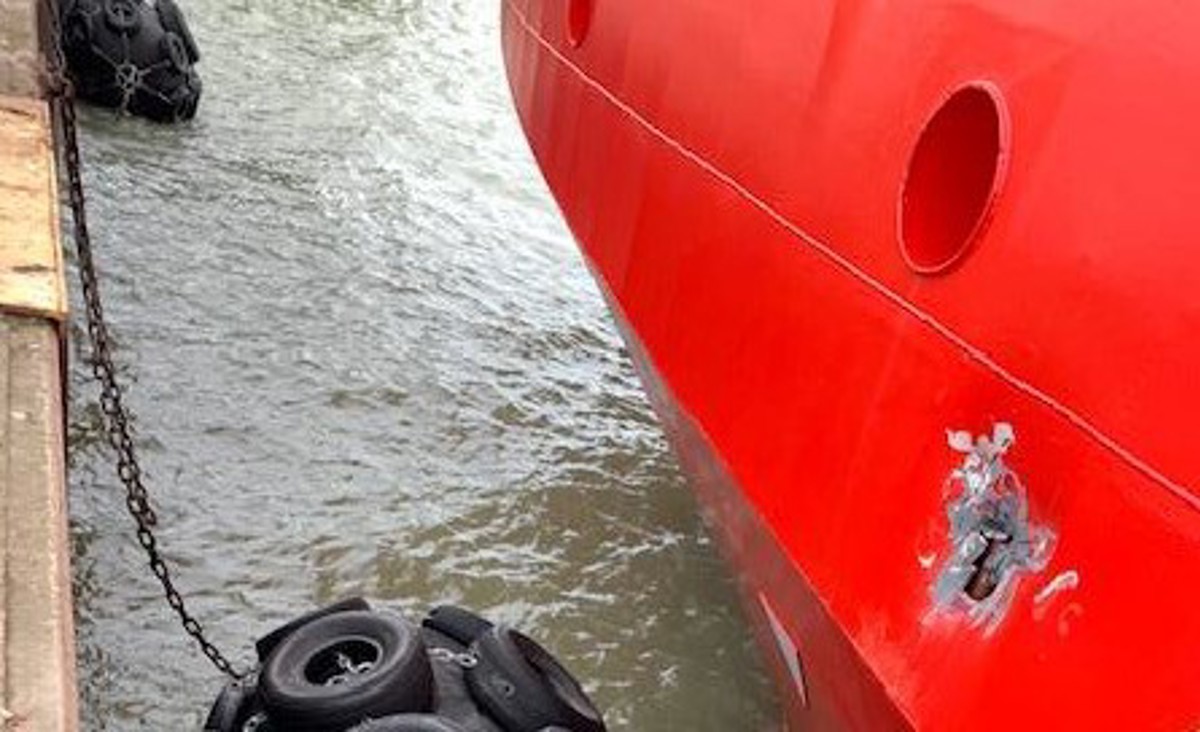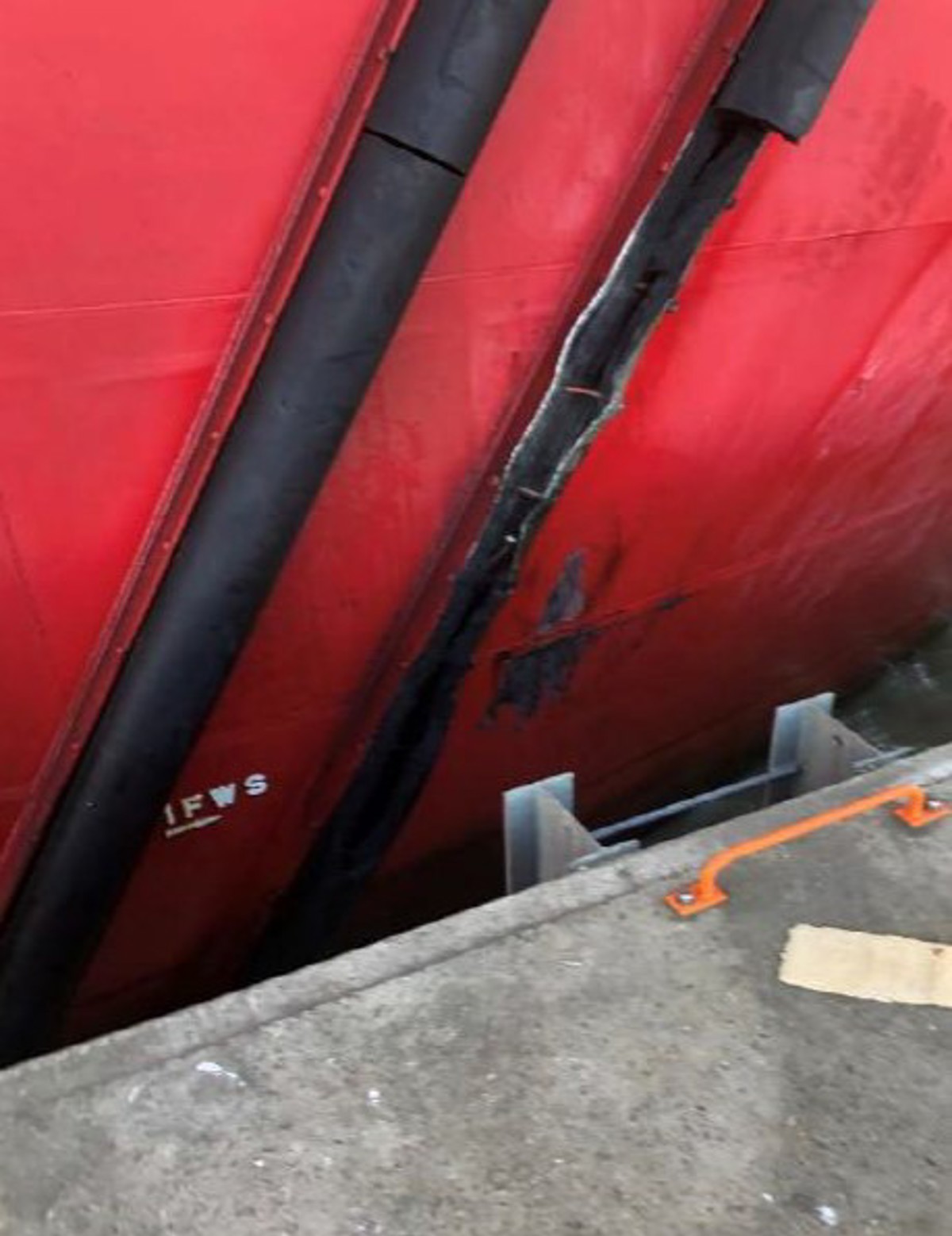Vessel hull damage due to quayside contact
- Safety Flash
- Published on 4 March 2021
- Generated on 5 July 2025
- IMCA SF 07/21
- 3 minute read
Jump to:
In two separate incidents at Great Yarmouth in the UK, two vessels have sustained damage to hull plating and hull fenders through contact with damaged, missing or misaligned jetty fendering arrangements.
What happened?
In one incident, a pad eye on the quayside edge made contact and penetrated the vessel hull plating.
At the time of the incident, the vessel was experiencing strong beam winds gusting up to 47 knots, pushing the vessel onto the quayside. Contact with the furthest forward fendering squeezed it out of position and underneath the quay structure. This allowed the forward section of the hull to come into contact with the protruding pad eye. It has become apparent that the fender resting place on the quay structure must have been previously damaged, enabling the fender to slide around the quayside supporting column.
In the second incident, the vessel experienced damage to the hull fender and hull mounted fender frame.
This was caused because there were no Yokohama fenders as expected, but instead large steel plates with sheets of rubber for the facing. The quayside location was exposed to the weather; the vessel experienced a heave of up to 2 metres, resulting in the wear down of the ship fender rubbing against the top edge of the quayside fender plate.

Vessel hull showing damage from pad eye
What went wrong?
In the first incident, the securing arrangements (pad eye) for the Yokohama fender must have been damaged at some point, but this was not reported to the vessel. This resulted in the Yokohama fender being able to move away from the jetty column and thus offering no protection to the vessel’s hull.
In the second incident, the vessel Master was expecting Yokohama fenders. Instead the berth was fitted with metal, rubber faced plate fenders, which were not suitable for the hull layout of the vessel and resulted in damage to the vessel’s hull plating and fixed fenders.

Damage to the hull fender and hull mounted fender frame
In both incidents weather conditions were a contributing factor.
Actions
- Wherever possible obtain a berthing plan in good time so as to make a full appraisal of fendering, mooring and gangway arrangements and request any necessary changes or clarifications.
- Ensure a pre-arrival toolbox talk is conducted so that all personnel involved in the berthing operation are aware of both shore-side and onboard mooring and fendering arrangements.
- Remain aware of the weather conditions when approaching the berth and if not satisfied with the situation, abort the approach and/or request tug assistance if appropriate and available.
- If it becomes apparent that the intended berth is not suitable, abort the approach and inform the Pilot/Port Authority and request alternative arrangements.
- Once moored alongside, monitor weather conditions including tidal variations which may affect the vessel movement and potential contact with quayside fendering, obstructions or infrastructure.
- Keep this handy list near your passage plan folder to ensure that future port calls consider same information.
Related Safety Flashes
-
IMCA SF 18/20
12 June 2020
-
-
IMCA SF 14/20
28 April 2020
-
-
IMCA SF 10/16
18 April 2016
IMCA Safety Flashes summarise key safety matters and incidents, allowing lessons to be more easily learnt for the benefit of the entire offshore industry.
The effectiveness of the IMCA Safety Flash system depends on the industry sharing information and so avoiding repeat incidents. Incidents are classified according to IOGP's Life Saving Rules.
All information is anonymised or sanitised, as appropriate, and warnings for graphic content included where possible.
IMCA makes every effort to ensure both the accuracy and reliability of the information shared, but is not be liable for any guidance and/or recommendation and/or statement herein contained.
The information contained in this document does not fulfil or replace any individual's or Member's legal, regulatory or other duties or obligations in respect of their operations. Individuals and Members remain solely responsible for the safe, lawful and proper conduct of their operations.
Share your safety incidents with IMCA online. Sign-up to receive Safety Flashes straight to your email.